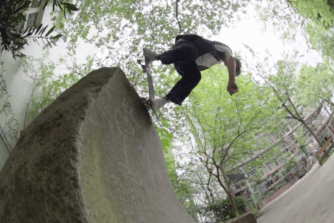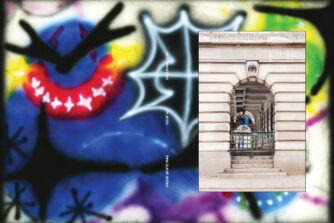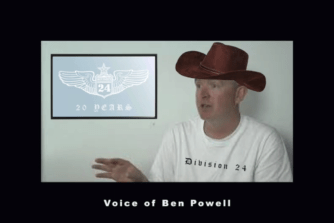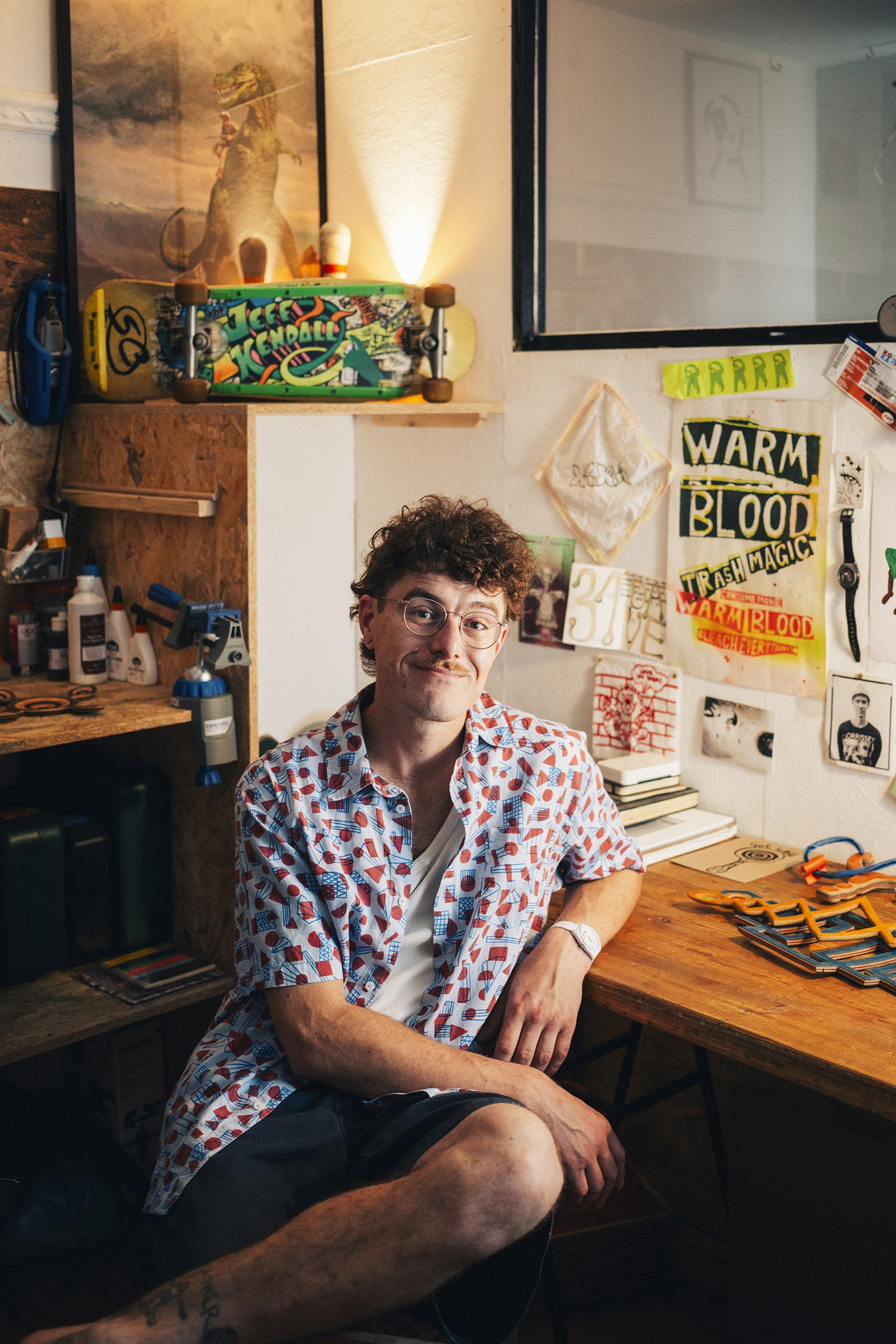
Photo by: Joel Peck
Introduction & Interview by Jono Coote
Photography by Joel Peck
It’s hard to believe in this age of social media-benighted instant gratification, but sometimes working on a skateboarding project involves the patience of a fisherman, and a bad one at that. Case in point, at the start of lockdown Dave Morgan and Isaac Wilkinson found themselves in Berlin with time on their hands and so started working on a mellow video project. Five years, eight broken foot bones, one country relocation and various life adjustments later, and we got an email seeing if we wanted to host the resultant part. ‘Get Well Spoon’ shared its title with an exhibition of Dave’s whittling work. This consists of abstract swirling curves which sooner or later reveal themselves to be said humble item of cutlery, pushing the boundaries of what constitutes a functional object whilst puncturing any efforts at pomposity; fun being the cornerstone of his work. Wanting to know more about Wakefield’s most influential spoon tinkerer, I hit Dave up to talk whittling, cobblestones, bluegrass and the point at which a hurricane becomes a mild breeze.

Photo by: Joel Peck
‘Get Well Spoon’ is obviously a reference to your spoon carving, and the fact of you absolutely mullering your foot in the midst of filming. Did you only start carving spoons in order to purposefully break yourself and then use that particular pun to give this part a title?
I wish it was an intentional pun. I’d made spoons before this. After studying at art school I had to downsize my work from large scale tree sculptures to something a bit more doable in a Mancunian bedroom. Then, when I moved to Berlin, me and Isaac started filming a part because Covid happened and we were both jobless. Fast forward a year, and I fully focused my foot skating this terrible miniramp with Yann Horowitz. They originally said I’d broken one bone, then after seven weeks I went back and they said I’d broken eight. I still can’t feel my big toe and there are certain tricks I can’t do anymore, which is a bit of a bummer, but I’ve learned how to do different ones, or to do things differently. My front foot is scuppered, and I’ve been partially blind in my left eye, which is my leading eye, since I was 15. Don’t fall asleep in contact lenses. I’ve got really bad depth perception, it’s like looking through frosted glass.
I read an article a few years ago about a woman in Taiwan who wore the same disposable contact lenses for six months, and amoebas ate out her eyes. So at least you didn’t do that.
I bet she won’t again. Anyway, I’d been working as a Deliveroo guy and I couldn’t do that so I was running out of money, and the ‘Get Well Spoon’ graphic was originally the start of a push to sell some artsy, crafty stuff and pay for my pasta and pesto. In Germany they do look after you if you’re on sick, but only for a limited time. With my foot I was out for nearly two years. After a year I still couldn’t walk, they couldn’t figure out why my foot wasn’t healing – and I think I went to 20 different hospitals. I even had a nerve treatment where they wrapped my foot in plasters containing Topical Capsaicin to completely burn all the nerves off, so they regrow without the trauma memory. Which was fascinating, but it did not work.
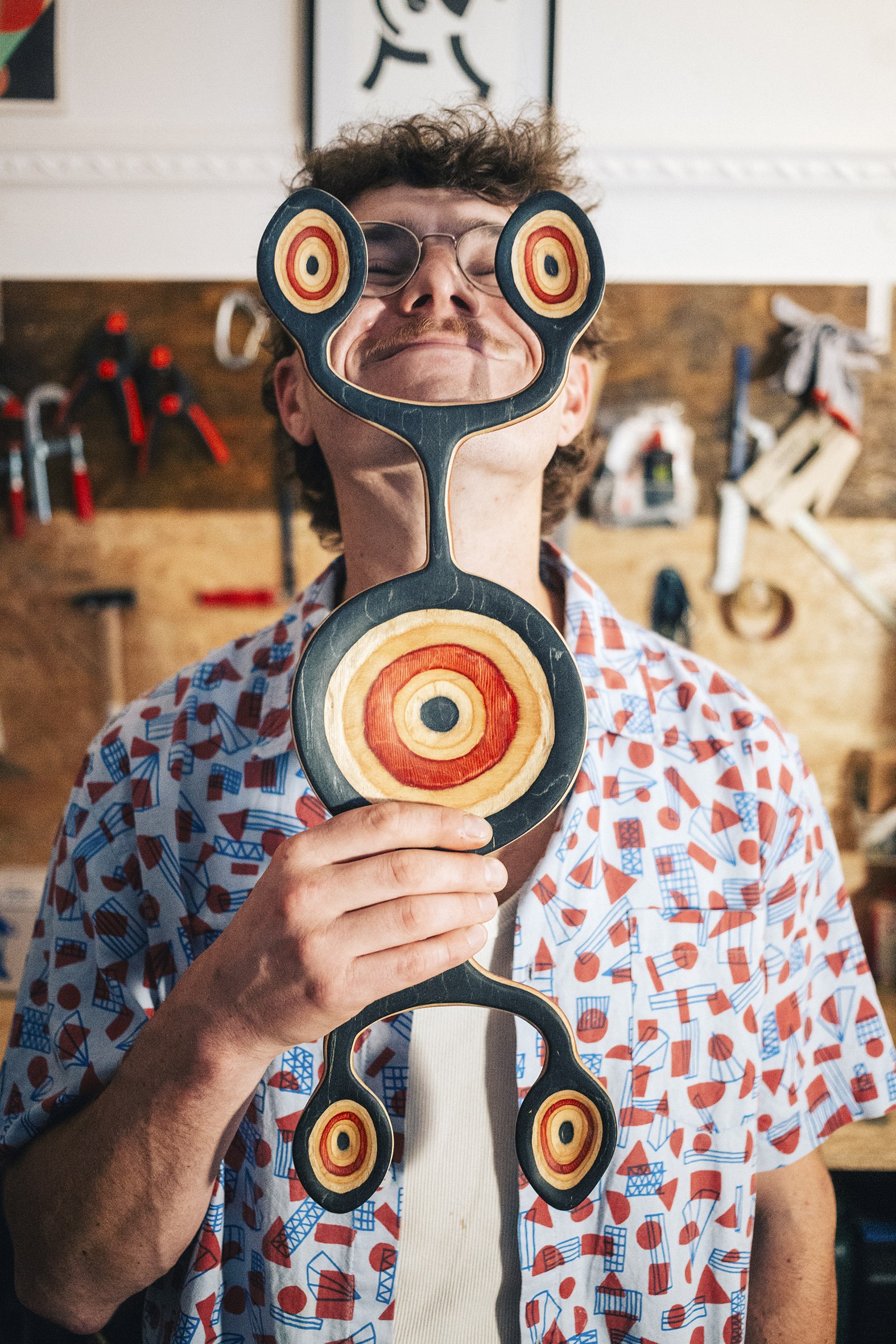
Photo by: Joel Peck
As evidenced by the footage this interview relates to, Berlin has loads of amazing spots which are entirely let down by the shit ground which surrounds them. How did you and Isaac go about deciding on spots?
The marble of Berlin is incredible, but let down by the archaic idea that cobbled sidewalks were brilliant when it came to rebuilding the city. You can have the most pristine spot, but there are four different kinds of cobbles in the run up to it. I found the majority of the spots looking through old Anzeiger Berlin back issues. It was this A5 mini-zine skate mag put together by this guy Adam Sello, and it showed all these crusty, underground spots that you never saw in Place or Monster Magazine. My friend gave me a load from the early 2000s and I’d ask the local guys where things were. Me and Isaac were both new to the city, we’d basically just pick a direction and cycle out. It was amazing until I broke my foot, and then we didn’t film anything for about three and a half years. By the time I could skate again, his cycling and filmmaking career had taken off. He’s getting paid a lot of money to film professional cyclists, the last thing he wants to do when he gets back is sit in a puddle, for free, and watch me shout at a bank.
Once it did all come together, how close a collaboration was the editing process and how did the song choice come about?
The majority of the video part was completed before I injured myself, then Isaac met his now-fiancé in South Africa last year and decided he was going to move there. I wrote to him in January, he came back this summer and, within a month, we managed to box off the last few tricks and sit through and edit. Editing was a lot more Isaac’s department; I’d give some suggestions, but I trusted him with it. I just wanted the video part to not be taken too seriously, so I scripted this little sketch that starts and ends the part. I’m carving a spoon in the woods, I fall asleep, there’s a bit of a dream sequence then suddenly I’ve carved my board into a spoon. Then I did the animations to go with it. One of my closest friends, Maité Steenhoudt, scripts a lot of these funny sketches in her video parts. There was one where she was in a hospital getting defibbed by two packs of Camel Blue and thrown out of the window as an inflatable doll. She was an inspiration; don’t get me wrong, she’s gnarly, but I also see her skating as one of the truest forms showing how fun skating can be.
And the song ‘In My Arrow’ is one I know from Blackalicious’ ‘Blazing Arrow’, but hadn’t listened to the original.
I came across that song because Harry Nilsson narrated a story book called ‘The Point’, about a guy and his dog that grow up in a fictitious village where everyone has a point on their head apart from this guy and his dog Arrow. My dad got me into Harry Nilsson when I was a kid, and I’d always found that such a fascinating song and a funny concept. I can’t recommend you listen to ‘The Point’ enough. I was kind of thinking, my arrow is my skateboard and it’s also kind of my spoon, as this spoon thing has become so heavily ingrained with what I do. I’ve normally got a little travel rack with a knife and spoon that I’ve cut out so I can carve wherever I go. It’s become an extension of me in a way, I’m either skateboarding or spoon making.
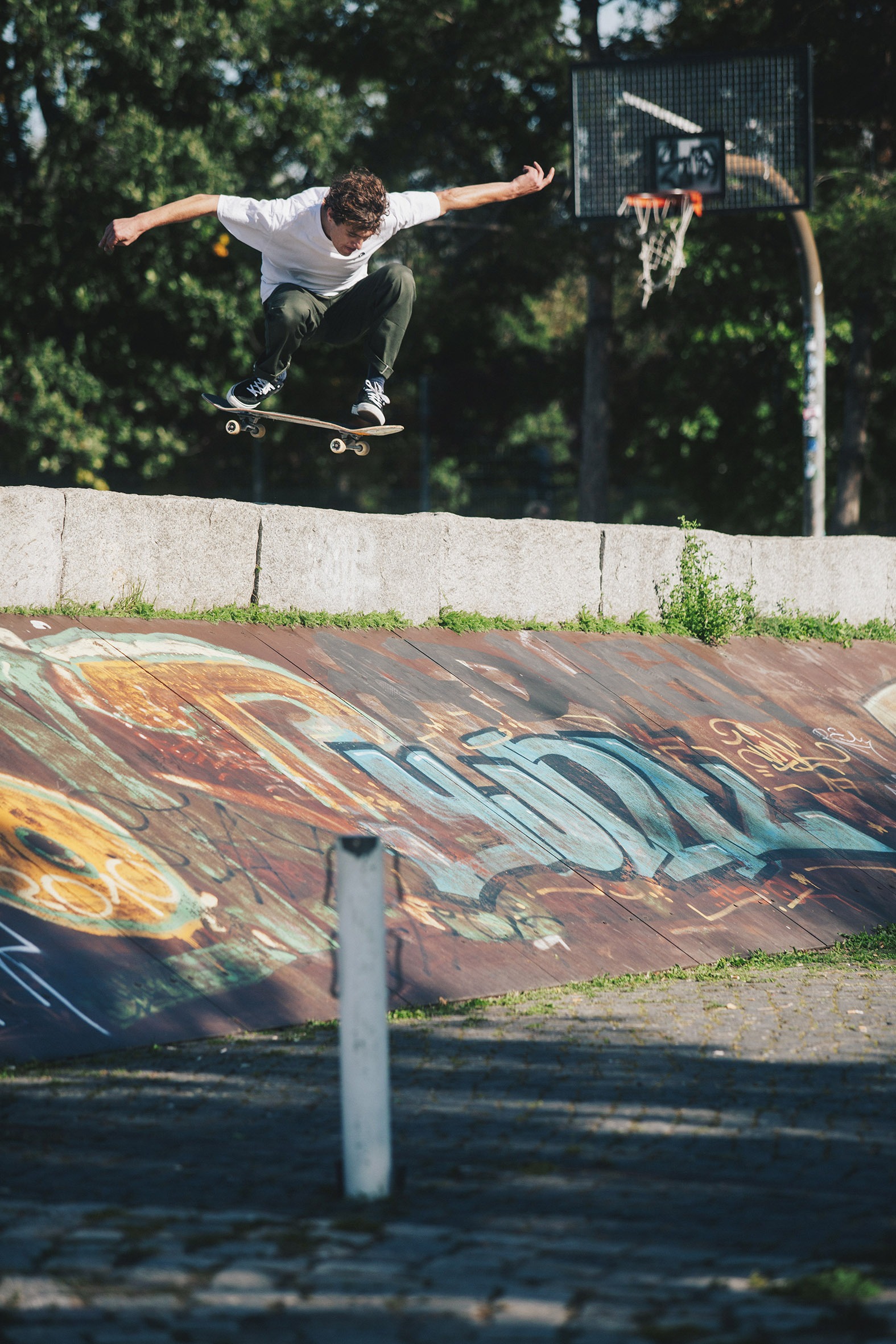
Dave Morgan – Wallie ~ Photo by: Joel Peck
I have got many spoon questions for you. But, first, what’s the story behind the backyard bowl you skate in the edit?
That’s a guy called Janno, he used to build for Yamato Skateparks. In Berlin they have these allotments called kleingartens, he has one of these gardens and he unofficially built one of the gnarliest backyard pools I’ve ever seen. It’s maybe 6ft in the deep and 2.5 or 3 in the shallow. You drop into the shallow and your nose hits the floor before your wheels do. Funnily enough, we had to go back to film that hurricane three times. That photo was taken the first time we did it, the clip in the video was the third because Isaac kept losing that clip. But I don’t hold it against him. Anyway, a lot of my friends meet up every Tuesday for a session there but I don’t skate it that often, it’s just so humbling. Also I like to turn my brain off when I skate, and normally skating transition is good for that, but that bowl is the kind of thing where you can’t turn your brain off.
But Thornes has some weird bits you kind of have to think about, like the jersey barrier on the bank…
See, that made sense to me. It’s hard to figure out how to get to, but once you’re up there… I just went into it with the same mentality as you would a wallride. Like I look at a bank to wall like a bank rising from the flat; if you picture the bank as nothing, then the wall is just a bank. I dissect tricks in the same way, like I always think of a frontside hurricane as a front rock with a little more pizzazz.
That’s how I approach them too. But I can only do them stalled, so they’re not hurricanes, they’re mild breezes. It’s only a hurricane if it grinds.
There you go, I didn’t know that.
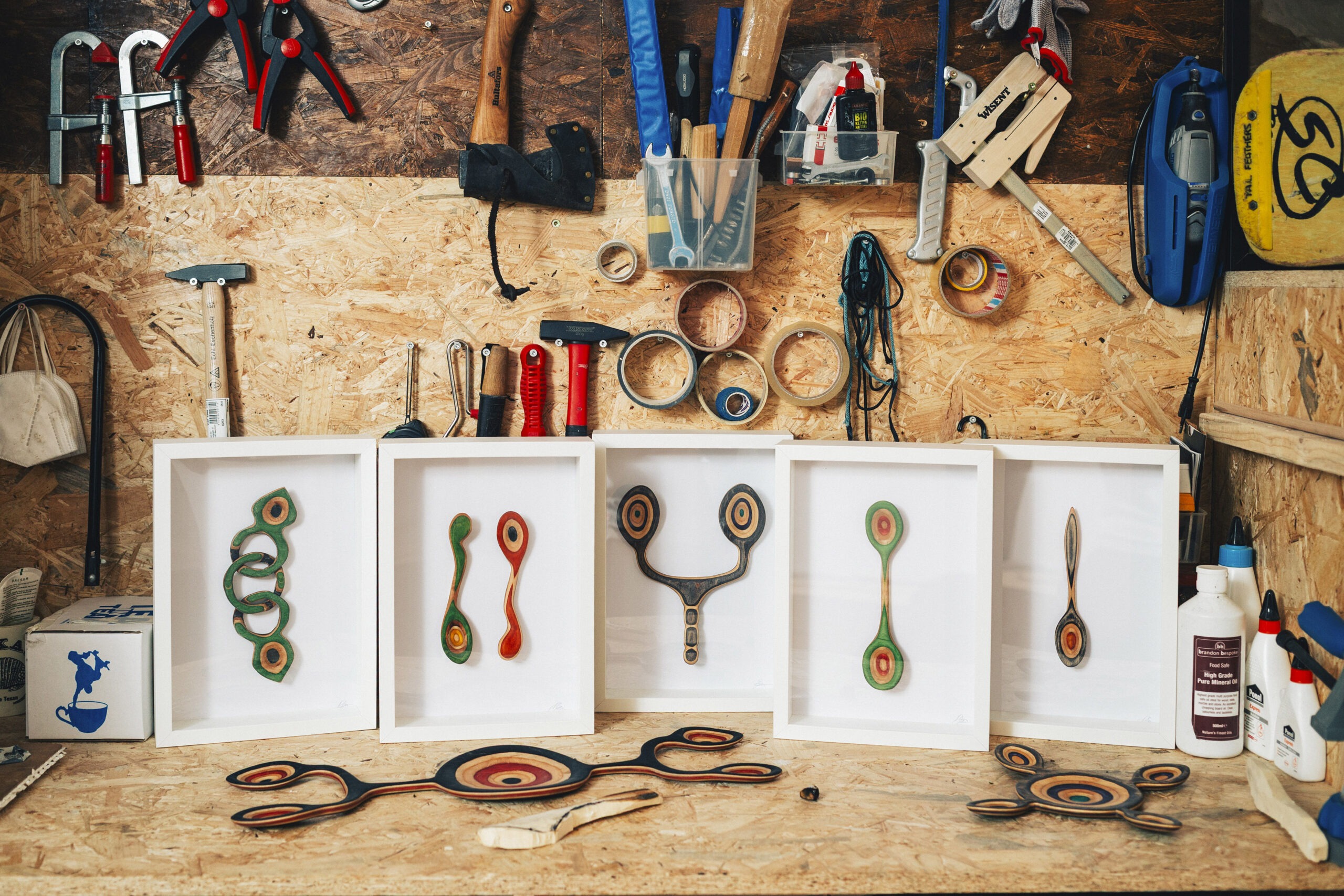
Photo by: Joel Peck
It’s something I’ve entirely made up, but I’m sticking by it. The title of the video part was shared by your recent exhibition. Can you tell us a little bit about your spoon carving and how you got into it?
I got into carving when I was at art school in Manchester. My tutor was a real traditional sculptor, he gave me a mallet and a chisel set and I started going to work on carving forms and obscure shapes out of trees I found. I loved not paying for materials, so I’d go out every morning to the park with my cruiser board, listening for a chainsaw. Then me, Neil Worthington and Ricky Davidson went to stay with a friend of mine called Wrennie in the Lake District, he’s a proper traditional whittler. He showed me how to do it and gave me my first hook knife; to make a spoon you need a hook knife and a sloyd, a straight blade. After that I started figuring things out for myself. Wrennie would show me tactics every now and then. He’s a great draughtsman so he’d draw me up ways to carve, what to do, what not to do. I got a few books, but the majority was down to me always living in skateboard houses so having this eternal supply of decks. I knew about traditional craft and whittling normal spoons but, other than seeing what Wrennie had done, I’d never seen people make spoons out of skateboards. I will admit, it’s horrible labour. There’s a reason people don’t make spoons out of skateboards, and that’s because it’s murder on your hands. Trying to hand carve through resin, heat-treated wood and all the rest is bloody awful. But the aesthetic you get at the end… like a lot in skateboarding, it’s a labour of love. Like a lot of people I’ve suffered with mental health issues, and the repetitive nature of spoon whittling makes it a meditative practice. It’s so rewarding; if you’ve had a bad day, you can just go sit with a spoon and a knife and it gives you a way to not just look at your phone on an evening. You can’t let your mind wander when you’re on four wheels, or holding a really sharp knife, or you’re going to come a cropper. It’s taught me a lot about how to focus my procrastination into productivity, as has skateboarding.
I’ve been doing that for maybe ten years now. Then my mum got me a little carving axe the other year, so I started to delve into traditional greenwood carving, which is interesting because there are no power tools involved at all. I’m a big believer in craft and traditionalist approaches to art, and there’s something beautiful in going into the forest with a saw, a knife and a flask of tea and returning with a functional object. That’s one thing with the spoons and stuff I make, it’s making something that has not just an aesthetic, but also a functional use. I find that really rewarding. That was one of the points of this exhibition, to see how far from a spoon I could make one; how impractical can a spoon be, and still be a spoon? I was playing around with framing; as soon as you put a spoon in a frame it loses its function, it’s no longer that utensil in the kitchen drawer, it’s an object with no function. I’d never even thought about that until I tried framing one; it was no longer what I had made, it had transitioned into something completely new and foreign. It was really exciting to start playing with that concept, seeing if I could make something that was a bog standard spoon but then make some really extreme ones that could technically be used, but are also very impractical. They have four heads, or one handle and two spoons. Like the Bauhaus, form follows function. Using functionality and building a form on top of it, how can something functional still be beautiful? I want to continue playing with that, how far you can push both the functionality and the objectivity before losing all reference.
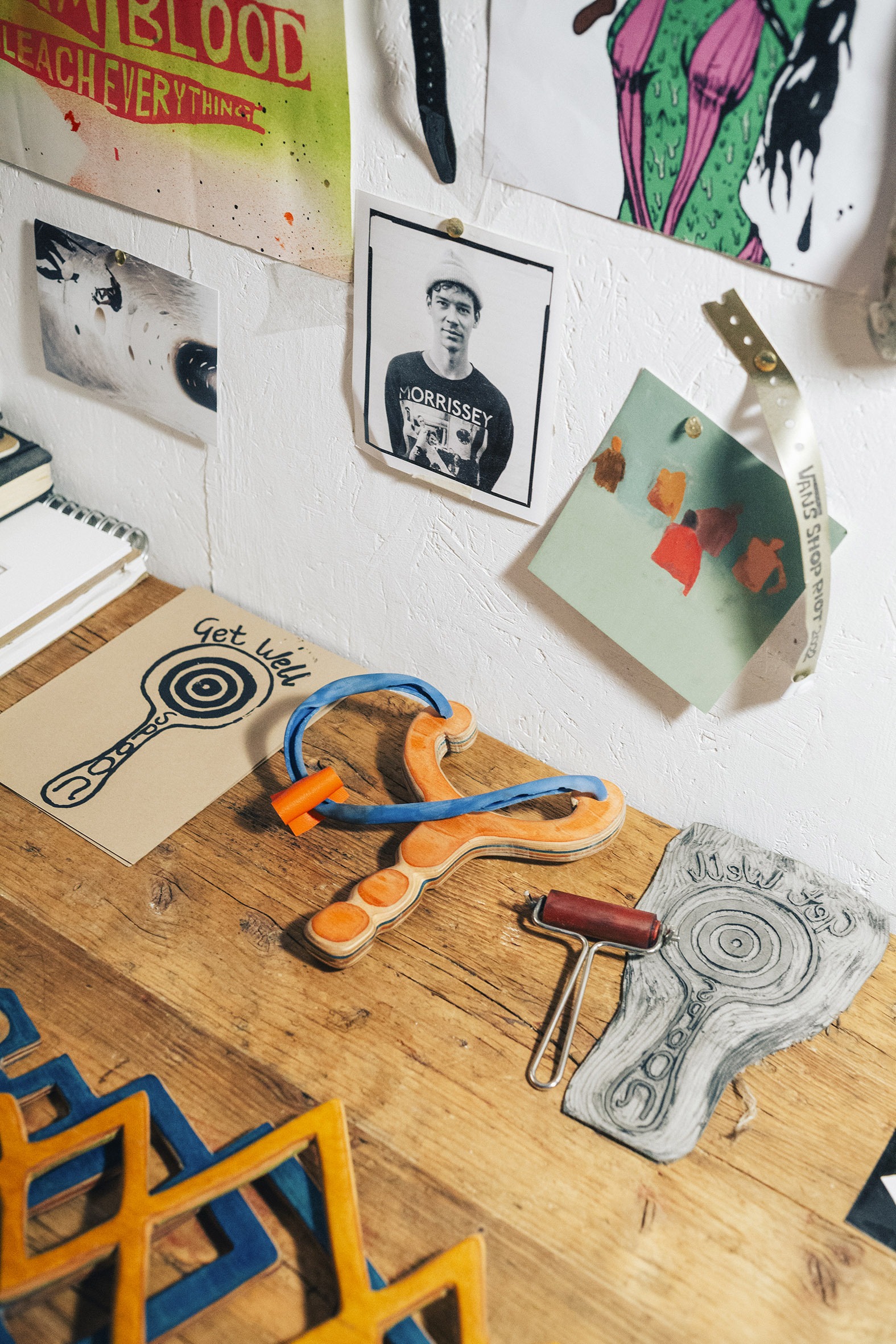
Photo by: Joel Peck
In the artist’s statement written for the exhibition you mention the ecological facet to your work, could you talk a bit about that?
We throw away so much. People will cut down a tree not even to use, just because it’s in the way and it’s left to rot into mulch. How many skateboards get snapped in half and thrown away? They’re not getting recycled unless you make a conscious effort to do so. That 70 quid board that you bought has travelled probably 9,000km to get to you, it’s used for a month then ends up in a landfill. Using found materials is me trying to consciously put things back out into the world that haven’t had their time yet. There’s something beautiful about using something that’s already had its presumed life. Some of the trees that I’ve carved, I’ve found out they were 500 years old before they were lopped down. It’s seen as done with, but that’s not necessarily its determined end. I’ll mention Giuseppe Penoni, who was associated with the Arte Povera movement, which in loose terms was a land art movement with a focus on art made with impoverished materials, those found within your grasp.
Wood as a medium presents its own challenges, how has your practice developed as you stumble across these?
It’s a constantly unpredictable medium, you’ll never get the same piece of wood twice. Even if you’re getting milled timber from B&Q then every piece has a different knot, a different grain. Working with skateboards, even more so; every board has been put through a different stress test by whoever has ridden it, you’re getting different coloured ply etc. I think I’ve learned how to use it more in my favour over the years through practise and experimentation. I’ve been really trying to work with as many different species of tree as I can find, to observe what differs in each species. Some you can carve super easily, some you can’t work on in one way because it will splinter off. Learning as you go is kind of the only way you can do it.
Who or what else do you take influence from when you’re carving – music you listen to, books you read, artists whose work you look at etc.?
Well I was raised in a musical family, both my parents are professional musicians. My dad was a composer and he introduced me to people like Philip Glass and Brian Eno, the hybrid of electronic and classical music. I was raised as a classical musician myself, and I listen to a lot of ambient music when I’m working. But, being a banjo player, I also listen to a lot of bluegrass. I’ll mention Noam Pikelny, who plays bluegrass in such a strangely melodic way that it doesn’t sound like it. That gave me a completely different perspective on the banjo. There’s a song called ‘Waveland’, I’ll send you it. I find a lot of inspiration in country music. But right now I’d say Philip Glass and country music.
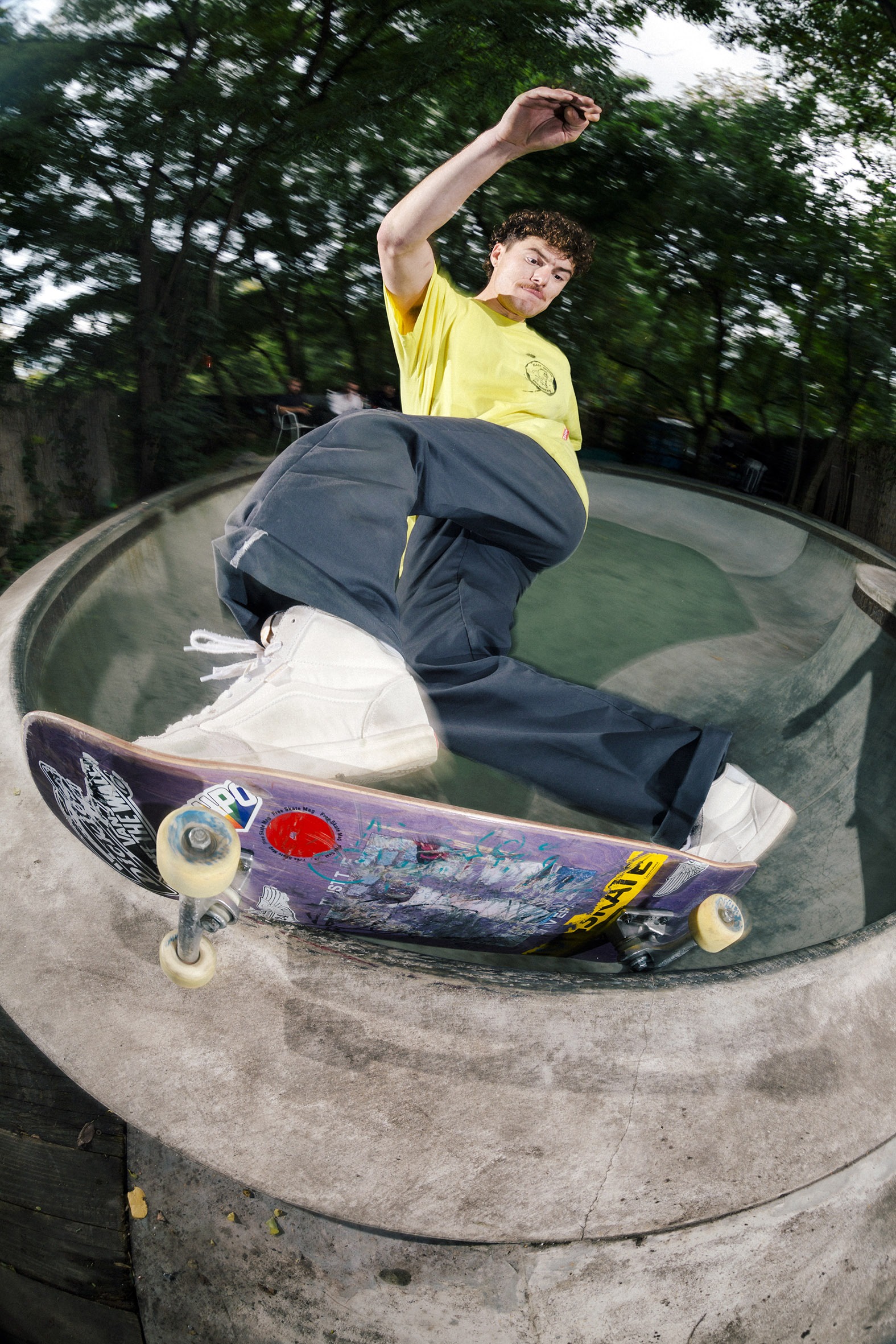
Dave Morgan – Frontside Hurricane ~ Photo by: Joel Peck
And with regards to banjo playing, you’d have witnessed Serious Sam Barrett picking it up more and more over the past few years.
Oh yeah, when I say country I also want to include folk music with that, and I’d say Serious Sam has been one of my biggest influences. Especially growing up in Wakefield and Leeds, after my dad had showed me what a twelve string was, then I saw Sam play… fucking hell, this is real music from the soul. This guy has been through shit and you can feel it in the music, it’s so palpable. He’s on daily rotation on my playlist. I wish I lived closer to Yorkshire so I could see him more these days.
If you had a visitor in Berlin for 48 hours on a non-skate excursion and you were to harness your inner Richard Ayoade, where would you take them?
I’d take them to Potsdam, which has the equivalent of the Palace of Versaille, this Prussian delusion of grandeur. Halfway there there’s a place called Peacock Island, with peacocks walking everywhere. I went there on mushrooms once and it was the most surreal experience of my life. You’re walking around, you turn around and there’s fifteen peacocks behind you, they’re so tame. I’d take them up the Victory Column, the one with the gold statue on top; an incredibly touristic thing. It’s €3.50 to enter it and go up to the top. It’s cheaper than a pint of beer and you get one of the best views of Berlin. You get to see all the bullet holes in the old staircases, it makes you realise how much history Berlin has held within the past hundred years. I find this city fascinating for that reason, so much has happened in so little time. What else could you do in 48 hours? I’d probably take you to one of my favourite lakes, Liepnitzsee, because there’s a natural spring under the lake so it has the clearest water you’ve ever seen. You’re walking through the forest and suddenly you think you’re in Switzerland, you see this vivid green translucent water. It’s like being in Laax. We’d take hammocks and go and have a swim.
Is there anything else you’d like to add?
Thank you to Joel Peck, he’s one of the first people I knew out here and it’s been a pleasure to shoot with him. Thanks to Isaac for being so supportive and dealing with my bullshit for so many years. The same with Sara Parsons. All of my Berlin crew, I’m so grateful for them because they made the move out here so much easier. Thanks to Wayne at Division 24, to Wapo, and to all the Vague homies. Also to James Collins, another dear friend I love to shoot with. Cheers to Stu Smith for making one of the raddest skate companies in the world, Lovenskate. That’s all I want to say, really.
Filmed + Edited by: Isaac Wilkinson



